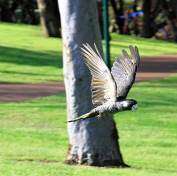New tracking program for Baudin's cockatoos

New knowledge about WA's endangered Baudin's cockatoos could be gained through an innovative tracking program beginning this week.
Researchers at Murdoch University and the Department of Parks and Wildlife will be releasing nine rehabilitated Baudin's cockatoos as part of the program and will track the birds' movements through their range to breeding and foraging sites in the south-west of Western Australia.
Murdoch University Associate Professor Kris Warren said the project provided an exciting opportunity to understand the migratory patterns of the birds and the key threats facing the species.
Very little is known about Baudin's cockatoos and this study will help identify the critical habitat used for breeding and feeding across the species' distribution in the State's south-west.
Associate Professor Warren said Baudin's cockatoos were under pressure from habitat loss through agricultural, forestry and mining development, as well as the impacts of fire and tree diseases, such as Marri canker.
Additional key threatening processes include illegal shooting, impacts of climate change, shortage of nest hollows in old trees and competition for nest hollows with other species.
"The birds nest in the hollows of old trees, which is a favoured home for other types of parrots, introduced European honey bees and even native ducks, so they are have to compete for limited habitat," she said.
Parks and Wildlife Senior Wildlife Officer Rick Dawson said Baudin's cockatoos were primarily forest dwellers and their range was consistent with Marri tree distribution.
"Up until now it has been very challenging to monitor flock movements and this tracking program might help increase our knowledge of this endangered species," he said.
The birds will be fitted and monitored with numbered and coloured leg bands, a satellite transmitter and a solar powered GPS tracker.
Murdoch University research team member Dr Jill Shephard said they would be using University of Amsterdam Bird Tracking System GPS trackers, which contain an accelerometer, which was an Australian first in parrot species and would enable unprecedented collection of ecological data.
"The GPS technology is particularly exciting as we will be able to gain an understanding of fine-scale movement by the birds, including when they are flying, eating or roosting," she said.
The team aims to track the birds for a year, with the devices naturally being removed over time through feather moulting or preening by the birds. The researchers hope to track Baudin's cockatoos using this technology annually for several years. Previous research has shown that the birds tolerate the satellite tracking devices well, and this enables long term tracking of tagged individuals and their associated flocks.
Provided by Murdoch University




















